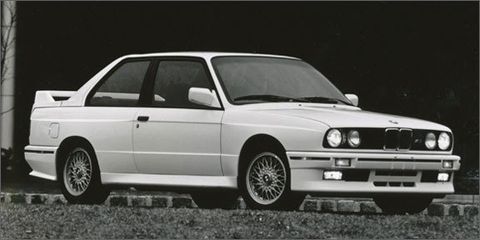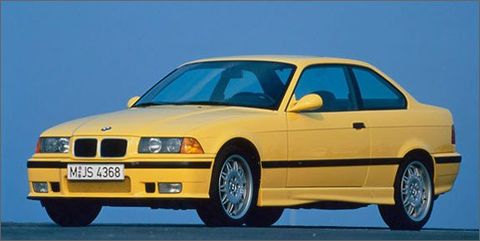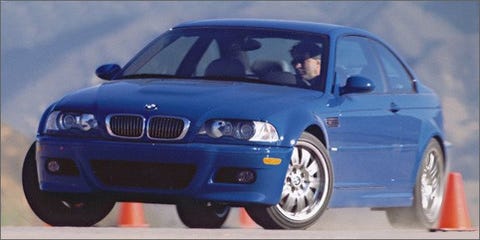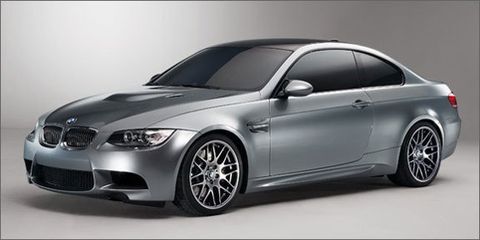Are E96 Bmws Easy to Work on
We recently had the opportunity to track-test all four generations of BMW's legendary M3. If you're like any of our editors who didn't get to go—so, any of us not named Robinson—reading about the exhilarating experience will have you scheming to cash in your bar mitzvah treasury bonds to park some version of the ultimate sports sedan in your garage. But which one to buy? The rough-and-ready first-generation model, the current V-8–powered luxo rocket, or something in between? Deciding can be tough, but don't get your lederhosen in a twist; we're here to help.
What follows is a primer for the used-M3 buyer in America. We'll stay away from problems inherent to the various generations of the 3-series as a whole—almost all suffer from short-lived control-arm bushings, window regulators, and rear shock mounts, for example—and focus on M3-specific issues.
In addition to numerous other independent and factory-authorized mechanics, key assistance in assembling this guide came from BMW technician Ben Thongsai of B&D Automotive in Westchester, Illinois. Thongsai co-founded the BMW Car Club of America's E30 M3 Special Interest Group and is widely regarded as one of the country's foremost authorities on BMW and M-car history.
U.S. Availability: 1988–91 model years
Market Value: Auction data are not available, and market observation indicates that most cars change hands privately. Low-mileage garage queens regularly bring $20,000, but $13,000 to $17,000 should snag a healthy driver with good cosmetics.
Why You Want an E30: The first-generation M3 was famously created to satisfy a homologation requirement for European touring-car racing. It was a motorsport weapon first and a sales exercise second. In reality, though, the E30 M3 isn't so much a sports car as a livable sedan with a trunk and back seat—one that happened to know its way around the Nürburgring long before it was de rigueur. The car's strengths lie in its astounding balance, impossibly forgiving suspension, and rock-solid reliability. The Baron von Asskicken styling and the peaky 7200-rpm four are just icing on the cake.
Choosing Which One: Although European buyers could opt for a host of special-edition and "evolution" M3s (they had more power), as well as a convertible, M3s sold in America came only as coupes, and only with a standard-pattern, wide-ratio manual transmission. (A close-ratio, dogleg five-speed gearbox was standard in the rest of the world.) Model-year updates and options in this country were all but nonexistent, which means your choices effectively come down to exterior color (red, white, silver, dark gray) and whether or not you want a driver-side airbag (1989–91).
Good-condition E30 M3s are relatively easy to locate in the U.S. Most marque specialists believe a healthy M3 is easier to source than a period 325i in similar condition. Just over 19,000 E30 M3s were built, and 5300 of those came to our shores starting in 1987 as 1988 models. Enthusiast forums and the BMW Car Club of America's classifieds are usually the best places to look.
Watch Out For: The E30 is widely considered to be the most durable and long-lived 3-series, and the M3 is no exception. The 2.3-liter four is often derided as a finicky, temperamental powerplant, but Thongsai says this reputation is undeserved. "Engine life depends on how the car has been driven," he says, "but well-treated ones should see 150,000 to 200,000 miles with no problem."
Check to see that regular valve adjustments have been performed (the factory specs a 30,000-mile interval), that engine and gearbox mounts are healthy (high cornering loads and a tall, buzzy engine increase wear), and that timing-chain noise isn't excessive. Cars that have been heavily tracked or otherwise abused suffer from connecting-rod-bearing wear, front subframe cracks, and body cracks or dimples. Having a mechanic inspect a prospective purchase before you buy is cheap insurance.
Track-focused modifications are common, so do your homework, and if in doubt, err on the side of stock. Aftermarket engine-management chips often make a noticeable difference in output and offer few drawbacks. Rust can show up anywhere on Snowbelt cars, but common locations include the base of the windshield, above the license-plate lights, and near the rocker panels.
U.S. Availability: 1995–99 model years
Market Value: High-mileage runner: $3900. Daily driver: $8000. Garage queen: $14,000 plus.
Why You Want an E36: The second-gen M3 was born of BMW's desire to grow the model and the M division as a whole, and as such, it was aimed at the ordinary speed junkie, not the E30's die-hard enthusiast. A smooth and torquey inline-six replaced the E30's screaming four, and the new engine's easy grunt and laid-back vibe matched the E36's quieter exterior and more comfortable cockpit. The brakes and the suspension components were uprated compared with those of the ordinary 3-series, but the E36 was still a few hundred pounds heavier than the 2800-pound E30.
Choosing Which One: The E36 M3 launched in the U.S. in 1995 with a 240-hp, 3.0-liter inline-six, developed specially for the American market (in fact, BMW wasn't planning on selling the M3 here at all but was ultimately persuaded by an enthusiasts' petition). This engine was replaced in 1996 with a 3.2-liter version, offering identical hp but 11 more lb-ft of torque at lower rpm.
A host of models was introduced, including the track-oriented 1995-only Lightweight—which cut some 225 pounds from the standard car—a convertible, and a four-door sedan. The E36 marked the debut of an automatic transmission in the M3, a five-speed unit from ZF. All told, over 36,000 U.S.-spec examples were sold.
With the exception of the rattly convertible and anticlimactic automatic models, there isn't a bad one in the bunch. A relatively fat production run means that countless colors and options packages are available and that many examples remain in good condition, so don't be afraid to be picky or hound used-car lots.
Watch Out For: Because the E36 shares a great deal of its components with lesser 3-series models—more than any M3 before or since—it's often the friendliest to maintain. The U.S.-spec drivetrain is similar to that of the E36 325i, which means parts are often cheap and easy to come by.
Problem areas are few. Early cars suffered from weak front strut towers, so check that the factory reinforcement plates have been fitted. An Achilles' heel cooling system means that water pumps and radiators should be considered 60,000-mile consumables. A failure of either can leave you stranded by the side of the road at best and destroy an engine at worst. Head gaskets generally fail between 100,000 and 150,000 miles. High-mileage cars can suffer from failed differentials above 100,000 miles; the U.S.-spec diff is smaller than the European one and can run hot, popping bearings and breaking flanges. Rust is commonly found on fender bottoms, in the bottoms of the doors, and on the edges of the trunklid.
As with the E30 M3, be extra careful when looking at cars that have been tinkered with. When the E36 M3s began to enter the used-car market, many enthusiasts added super- and turbochargers—sometimes not carefully. Because the E36 was a mainstream car, owners range from apex-snarfing track hounds to soccer moms who simply wanted the hottest 3 on offer, and maintenance might not have been up to factory specs.
U.S. Availability: 2001–06 model years
Market Value: High-mileage runner: $13,000. Daily driver: $18,000. Garage queen: $25,000.
Why You Want an E46: The E46 M3 combined many of the best qualities of the two M3s that came before it, effectively silencing any complaints that BMW's M division had grown complacent. Unlike the E36 it replaced, the E46 M3 was carefully differentiated from its lesser brethren. Mechanically, this meant that countless suspension and body components—everything from control arms and subframes to damper anchor points—were strengthened, stiffened, or relocated in the search for speed and durability.
Cosmetically, the E46 paid homage to the E30 with special fender flares front and rear, and its fender vents were meant to recall the 3.0CSL of the 1970s. (Little did BMW know they would become a popular glue-on accessory for every pimped ride—and then factory-produced models—during the next few years.)
Under the E46's domed aluminum hood, BMW again installed a 3.2-liter inline-six, this version being an evolution of the more expensive engine that powered European E36s. It spat out 333 hp and a coarse metallic rasp, leaping for its 7900-rpm redline like a machine possessed. This should be more than enough to satisfy enthusiasts who are concerned about the E46's 3450-pound curb weight.
Choosing Which One: Like the E36, the E46 M3 was offered in a wide variety of colors and with numerous options. The sedan configuration, however, was dropped for the E46, and coupes are more common—and desirable—as the convertibles pair a too-stiff suspension with a scuttle-shake-prone chassis.
Model-year changes were minimal, the most significant being the introduction of BMW's six-speed sequential manual gearbox (SMG), an electronically shifted version of the M3's standard six-speed manual. U.S. buyers were turned off by its punishing shifts and lack of involvement, so traditional sticks are more common in the E46 M3s here.
Although Americans couldn't buy the lightweight CSL model introduced to Europe in 2003, select CSL parts were later found in the 2004–06 Competition Package variant that offered a quicker steering rack; unique wheels and trim; and larger, cross-drilled brakes. Cars so equipped are the most difficult to come by; happily, you can easily build one by cracking open your checkbook and a factory parts catalog.
This was the first M3 offered with factory navigation, and cars so equipped tend to be worth slightly less on the used market, but that varies with location and overall condition. BMW's certified pre-owned lots and the enthusiast classifieds are generally the best places to look.
Watch Out For: The E46 is a fairly stout car, and it offers a beguiling combination of straight-line speed and modern polish. Durability, Thongsai says, is less of an issue than it is for the E36, and he notes that the E46 tends to cope better with hard use—everything from suspension-bushing life to interior wear is improved—than its predecessor. "The cooling systems are usually a bit longer-lived," he says, "and the thermostat is set to run a little cooler than it does on the E36, which may help. By and large, when driven sensibly, they seem to hold up."
Other issues: Early cars suffered from rod-bearing issues that were dealt with by a factory recall, so check with your local dealer to make sure this has been done to any car you might be considering. SMG-equipped examples often suffer from hydraulic-pump failure; the pump costs several thousand dollars. (As of this writing, a replacement clutch slave cylinder is nearly 1000 bucks.) As with the E30, valve adjustment is required every 30,000 miles.
U.S. Availability: 2008–present
Market Value: High-mileage runner: wait a few years. Daily driver: $38,000. Garage queen: $46,000. Convertibles command a premium.
Why You Want an E90: The current M3, introduced in 2008, is arguably the best of the bunch. The ingredients are simple: a thundering 414-hp, 4.0-liter V-8; a stiff chassis; massive wheels and tires; a six-speed manual or seven-speed dual-clutch automated manual; and all the wheelspin you can stand. It's an excellent package, the kind of involving, talkative car that we stay up nights thinking about.
Choosing Which One: A folding-hardtop convertible and a four-door sedan are offered alongside the standard coupe, and as with the E36, it's hard to go wrong when choosing a body style.
At this point, a dealer is almost your only option, and if you're the cautious type, it's the best. Still, you can snag a lightly used E90 for significantly less than MSRP. Check out BMW's certified pre-owned program that offers the time-honored Bavarian new-car smell but punches a slightly smaller hole in your pocketbook.
Watch Out For: Not a lot. The typical used-car warnings will serve you well here: Buy the newest and lowest-mile example you can afford, make sure it's still covered under warranty, and if you have any doubts, have your local dealer perform a prepurchase inspection. Check the records: Regular oil changes (read "anything at least as often as BMW's recommended interval") are a must, and any maintenance beyond regular services—and performed anywhere but the dealer's—should be eyed warily.
If you're industrious, you can learn a great deal from the little things. Given that most E90 M3s are probably still on their first set of tires, a careful look at the tread should tell you how the car has been driven. (If the tires show blistering and zero tread depth, run away.) Leaking fluids are also a warning sign and potentially indicate that part of the drivetrain has gotten very hot—a possible giveaway to track use or drag racing.
No Matter Which You Choose, You Can' t Lose
"It all depends on what you want," Thongsai says. "One school of thought holds that newer is better. The E90 is certainly the fastest and most luxurious of the bunch, but it's also the heaviest. The E46 is probably a little rough to live with every day, unless you don't mind things like a firm ride and an engine that needs to be wound out. The E36 is now a fairly common vehicle, but it's also the easiest to live with. Surprisingly enough, the E30 makes a great daily driver, but if you live where it snows a lot, you have to be okay with having it rust away underneath you."
For reference, Thongsai prefers the '88 E30. Us, we're torn, but that's no surprise. Guess it's time for a bigger garage.
Source: https://www.caranddriver.com/features/a15125529/bmw-m3-buyers-guide/




0 Response to "Are E96 Bmws Easy to Work on"
Post a Comment